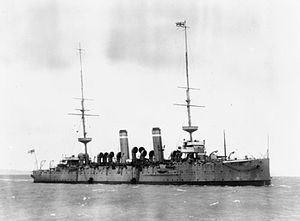HMS Eclipse (1894)
 Eclipse during World War I
| |
| History | |
|---|---|
| Name | HMS Eclipse |
| Builder | Portsmouth Dockyard |
| Laid down | 11 December 1893 |
| Launched | 19 July 1894 |
| Completed | 23 March 1897 |
| Fate | Sold for scrap, August 1921 |
| General characteristics | |
| Class and type | Eclipse-class protected cruiser |
| Displacement | 5,600 long tons (5,690 t) |
| Length | 350 ft (106.7 m) |
| Beam | 53 ft 6 in (16.3 m) |
| Draught | 20 ft 6 in (6.25 m) |
| Installed power | |
| Propulsion | 2 shafts, 2 Inverted triple-expansion steam engines |
| Speed | 18.5 knots (34.3 km/h; 21.3 mph) |
| Complement | 450 |
| Armament |
|
| Armour |
|
HMS Eclipse was an Eclipse-class protected cruiser built for the Royal Navy in the mid-1890s.
Design
Eclipse-class second-class protected cruisers were preceded by the shorter Astraea-class cruisers. Eclipse had a displacement of 5,600 long tons (5,700 t; 6,300 short tons) when at normal load. It had a total length of 373 ft (114 m), a beam of 53 ft 6 in (16.31 m), a metacentric height of around 3 m (9 ft 10 in), and a draught of 20 ft 6 in (6.25 m).[1] It was powered by two inverted triple-expansion steam engines which used steam from eight cylindrical boilers. Using normal draught, the boilers were intended to provide the engines with enough steam to generate 8,000 indicated horsepower (6,000 kW) and to reach a speed of 18.5 knots (34.3 km/h; 21.3 mph); using forced draft, the equivalent figures were 9,600 indicated horsepower (7,200 kW) and a speed of 19.5 knots (36.1 km/h; 22.4 mph). Eclipse-class cruisers carried a maximum of 1,075 long tons (1,092 t) of coal and achieved maximum speed of 20 knots (37 km/h; 23 mph) in sea trials.[2]
It carried five 40-calibre 6-inch (152 mm) quick-firing (QF) guns in single mounts protected by gun shields. One gun was mounted on the forecastle, two on the quarterdeck and one pair was abreast the bridge.[3] They fired 100-pound (45 kg) shells at a muzzle velocity of 2,205 ft/s (672 m/s).[4] The secondary armament consisted of six 40-calibre 4.7-inch (120 mm) guns; three on each broadside. Their 45-pound (20.4 kg) shells were fired at a muzzle velocity of 2,125 ft/s (648 m/s).[5] It was fitted with three 18-inch torpedo tubes, one submerged tube on each broadside and one above water in the stern.[6] Its ammunition supply consisted of 200 six-inch rounds per gun, 250 shells for each 4.7-inch gun, 300 rounds per gun for the 76 mm (3.0 in)s and 500 for each three-pounder. Eclipse had ten torpedoes, presumably four for each broadside tube and two for the stern tube.[7]
Service
HMS Eclipse was launched in 1894 and completed in 1897. In 1899 she served in the Indian Ocean under the command of Captain P. W. Bush, as flagship of the East Indies Squadron.[8]
She was commissioned at Chatham dockyard in late May 1901, with a crew of 450 officers and men under the command of Captain Stokes, to relieve HMS Hermione on the China Station.[9]
On the outbreak of the First World War she formed part of the 12th Cruiser Squadron, which patrolled at the Western end of the English Channel, with particular duties to stop suspicious vessels and prevent disguised minelayers from interfering with cross-Channel traffic.[10][11]
Footnotes
- ^ McBride, pp. 138–39
- ^ McBride, pp. 137–39
- ^ McBride, p. 137
- ^ Friedman, pp. 87–88
- ^ Friedman, p. 92
- ^ Chesneau & Kolesnik, p. 78
- ^ McBride, p. 139
- ^ "Naval & Military intelligence". The Times. No. 36040. London. 16 January 1900. p. 9. template uses deprecated parameter(s) (help)
- ^ "Naval & Military intelligence". The Times. No. 36469. London. 31 May 1901. p. 4. template uses deprecated parameter(s) (help)
- ^ Naval Staff Monograph No. 23 1924, pp. 54–56.
References
- Chesneau, Roger; Kolesnik, Eugene M., eds. (1979). Conway's All the World's Fighting Ships 1860–1905. Greenwich, UK: Conway Maritime Press. ISBN 0-8317-0302-4.
- Corbett, Julian S. (1920). History of the Great War: Naval Operations: Volume I: To the Battle of the Falklands December 1914. History of the Great War. London: Longmans, Green & Co. OCLC 3759388.
{{cite book}}: Invalid|ref=harv(help) - Friedman, Norman (2011). Naval Weapons of World War One. Barnsley, South Yorkshire, UK: Seaforth. ISBN 978-1-84832-100-7.
- Gardiner, Robert; Gray, Randal, eds. (1984). Conway's All the World's Fighting Ships: 1906–1921. Annapolis, Maryland: Naval Institute Press. ISBN 0-85177-245-5.
- McBride, Keith (2012). "The Cruiser Family Talbot". In John Jordan (ed.). Warship 2012. London: Conway. pp. 136–41. ISBN 978-1-84486-156-9.
- Monograph No. 23: Home Waters—Part I: From the Outbreak of War to 27 August 1914 (PDF). Naval Staff Monographs (Historical). Vol. X. The Naval Staff, Training and Staff Duties Division. 1924.
- Monograph No. 31: Home Waters—Part VI: From October 1915 to May 1916 (PDF). Naval Staff Monographs (Historical). Vol. XV. The Naval Staff, Training and Staff Duties Division. 1926.
